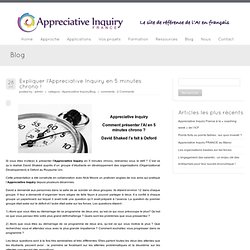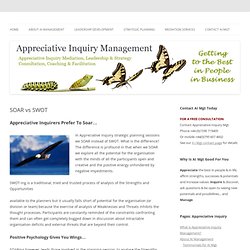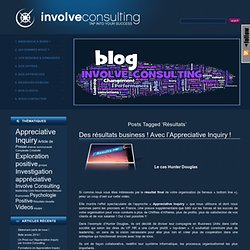

The Appreciative Inquiry Commons. Appreciative Inquiry Consulting & Training – Corporation for Positive Change. Expliquer l’Appreciative Inquiry en 5 minutes chrono ! - Appreciative Inquiry France. Si vous êtes invité(e) à présenter l’Appreciative Inquiry en 5 minutes chrono, relèveriez vous le défi ?

C’est ce qu’a réalisé David Shaked auprès d’un groupe d’étudiants en développement des organisations (Organizational Developement) à Oxford au Royaume Uni. Cette présentation a été construite en collaboration avec Nick Moore un praticien anglais de nos amis qui pratique l’Appreciative Inquiry depuis plusieurs décennies. David a demandé aux personnes dans la salle de se scinder en deux groupes.
Ils étaient environ 12 dans chaque groupe. Il leur a demandé d’organiser leurs sièges de telle façon à pouvoir partager à deux. 1) Alors que vous êtes au démarrage de ce programme de deux ans, qu’est ce qui vous préoccupe le plus? 2) Alors que vous êtes au démarrage de ce programme de deux ans, qu’est ce qui vous motive le plus ? Les deux questions sont à la fois très semblables et très différentes.
SOAR vs SWOT – Appreciative Inquiry Management. Appreciative Inquirers Prefer To Soar… In Appreciative Inquiry strategic planning sessions we SOAR instead of SWOT.

What is the difference? The difference is profound in that when we SOAR we explore all the potential for the organisation with the minds of all the participants open and creative and the positive energy unhindered by negative impediments. SWOT-ing is a traditional, tried and trusted process of analysis of the Strengths and Opportunities available to the planners but it usually falls short of potential for the organisation (or division or team) because the exercise of analysis of Weaknesses and Threats inhibits the thought processes.
Positive Psychology Gives You Wings… SOARing however, leads those involved in the planning session, to analyse the Strengths, Opportunities, Aspirations and desired Results, therefore liberating the minds of the planners. PS… SOAR & SWOT … A Popular Debate! Please visit this SOAR VS SWOT 2 post and leave your comment. About AI Books and Articles (by Joeri Kabalt) We received this e-mail from Joeri Kabalt, presenter at the conference.

She provided us a beautiful list of interesting literature around the different keynotes we couldn’t keep a secret for you. “Dear Colleagues, What a great conference! During the conference and especially during and after the keynotes, I have talked with some of you about articles written or mentioned by the keynotes. And promised to send some of them to you. So for those of you who are inspired by the conference and interested in doing some extra reading, I have some reading suggestions. This is quite a nice little article from the AI practitioner, ‘back to basics’ by Dian Marie Hosking and Sheila McNamee, which describes the basic assumptions of Social Constructionism and how these inform AI theory and AI practices ( Keynote David Cooperrider: You’re probably familiar with David Cooperrider’s more practical work (AI Handbook and such).
Keynote Diana Whitney: Keynote Ken Gergen: Keynote Gervase Bushe & Ron Fry: PRAGMA: Artisan de la relation humaine dans l'entreprise. Appreciative Inquiry vs Problem Solving.mov. Hunter Douglas - Appreciative Inquiry Case Study. Résultats « Involve Consulting – La performance collective par l'Appreciative Inquiry. Dimanche, novembre 27, 2011 Si comme nous vous êtes intéressés par le résultat final de votre organisation (le fameux « bottom line »), jetez un coup d’oeil sur cette vidéo.

Elle montre l’effet spectaculaire de l’approche « Appreciative Inquiry » que nous utilisons et dont nous sommes parmi les pionniers en France. Une preuve supplémentaire que bâtir sur les forces et les succès de votre organisation peut vous conduire à plus de Chiffres d’Affaires, plus de profits, plus de satisfaction de vos clients et de vos salariés !
Oui c’est possible !! Dans l’exemple d’Hunter Douglas, ils ont décidé de diviser leur compagnie en Business Units dans cette société qui selon les dires du VP HR a une culture plutôt « top-down ». Ils ont de façon collaborative, redéfini leur système informatique, les processus organisationnel les plus importants. L’un des résutats « bottom line » : le rendement :la productivité qui est passée de 84% à 90%. Hunter Douglas site internet :